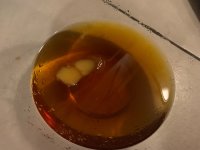W-h-o-a -- 55 Gal! I don't know what I would do with all of that.
So many people "use the system" to get a tool/product and then return it for a full refund.
This is an experience that was a bummer for me. I replaced my old rickety wooden pull down ladder that gave me access to the garage attic. I went to the lumber yard and bought a nice Werner aluminum attic pull down ladder. My garage has 10 ft. ceilings. When I got the "new" ladder home I found out someone had returned the ladder for a refund. However, I couldn't use the ladder, because the legs were cut off for an 8 ft. ceiling. So, I took it back and got a really "brand new" ladder and was able to cut the legs off for a 10 ft. ceiling. Besides the pain, of returning the used one, the store has to take up a loss. They can't do that or go out of business, so they have to up their prices -- and who pays the increase -- we do.
W-h-o-a -- 55 Gal! I don't know what I would do with all of that linseed oil. I wonder what it would cost. I think the Raw is getting harder to get. Did you notice the price for 1 Gallon of the Raw ($40!). Just a year or two ago, I paid $12 for one gallon. I would guess that in a short time, the Raw will be taken off the market for some reason or another.Thanks, I don’t think I was clear. I’d really like to find 5-gal cans or a 55-gal drum of raw. The gal cans of “bolied” linseed oil are fine for the small projects.
BTW, speaking of spraying finishes I once bought a plastic pump sprayer from Home Depot, opened it at home and found that some had bought it, used it for deck stain, then returned it without even cleaning it. HD told me people do that all the time, using HD as a free rental store. Dirtballs - I couldn’t live like that…
So many people "use the system" to get a tool/product and then return it for a full refund.
This is an experience that was a bummer for me. I replaced my old rickety wooden pull down ladder that gave me access to the garage attic. I went to the lumber yard and bought a nice Werner aluminum attic pull down ladder. My garage has 10 ft. ceilings. When I got the "new" ladder home I found out someone had returned the ladder for a refund. However, I couldn't use the ladder, because the legs were cut off for an 8 ft. ceiling. So, I took it back and got a really "brand new" ladder and was able to cut the legs off for a 10 ft. ceiling. Besides the pain, of returning the used one, the store has to take up a loss. They can't do that or go out of business, so they have to up their prices -- and who pays the increase -- we do.



